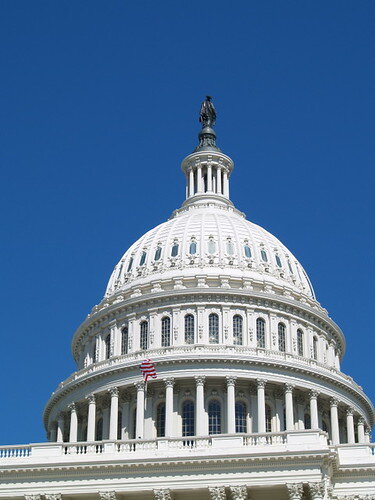Youth in Politics— The Next Frontier for Democratic Representation?
By: Jonathan Pezzi
Capitol 6 by Alan Sharp
Lexington — In April 2018, Mark Zuckerberg, Founder and CEO of Facebook, testified in front of the Senate Judiciary Committee following a series of privacy scandals involving the 2016 Presidential Election. The personal information of about 300,000 Facebook users was collected from a personality quiz. The information of those users and their friends, a total of roughly 87 million people, was then shared with Cambridge Analytica, the British analytics firm that used personal data to target vulnerable voters and help Donald Trump’s presidential campaign.
On the days Zuckerberg took questions from the committee, millions watched as elderly Senators struggled to even grasp what Facebook actually does. Senator Orrin Hatch of Utah, a then 84-year-old incumbent Senator, did not understand how Facebook made its money and felt compelled to ask during the hearing itself.
The hearing understandably spurred a discussion about the aging of our legislators. As many of the rising threats to the United States are technological, from election tampering to cyber warfare, some expressed concern following the obvious disconnect.
Although this topic did create waves in the public discourse regarding representation, America’s national bodies do not seem to be significantly affected. No matter who wins the election in November, they will be one of the oldest presidents in American history. The average member of the House of Representatives and Senate is 58 and 62 respectively. Nearly half of US Senators are over the age of 65.
While the average politician is entering their elder years, the average American they’re representing is not yet 40. In fact, while Americans between the ages of 18-45 make up nearly 40% of the population, they make up approximately 20% of the national legislature. The numbers for local legislatures are incomplete, but the proportion is possibly even smaller.
So why is this the case?
Like many phenomena, it can’t be concentrated to any one reason.
“There are too many factors on why youth aren’t as involved. But when you boil it down, it’s about access. And it’s about access to resources, education about civics, the physical systems, access to leaders themselves. All of these are placed on top of each other and burden down the possibility for young people to get involved,” says Francis Wilson, Host of Youth Got the Power, a podcast investigating young people in politics. Wilson is also a consultant and researcher for youth-led political campaigns.
Pictured: Francis Wilson, host of Youth Got the Power and youth-in- politics researcher. Photo courtesy of Francis Wilson
To Wilson, access means many things. “There are systemic challenges to American youth running for office. And it has to do with how we build elections, to begin with. We have age limits, we have a hard cut-off for eighteen-year-olds for voting.”
But these systemic issues are sometimes less concrete Wilson says. For his college thesis, Francis drove around the United States, talking with candidates under 25 running for office. He wanted to know how many young people are actually getting involved in elections, but also better understand why there aren’t that many to begin with. “What I found ultimately, and what I wrote about in my thesis, was ageism and age discrimination. I didn’t originally think I’d end up writing about it. There is no literature on it.”
The reality, Wilson believes, is that we have built a society that does not value youth in politics. “Once we start to normalize the narrative, more people will understand that they too can run. And then, they’ll start to win.”
Santino Guerra, first elected to Flint, Michigan’s City Council at 19, faced other roadblocks. “The biggest roadblock for young people is resources and legacy,” Santino told Via News.
Photo of Councilman Santino Guerra. Courtesy of Mr. Guerra
“People just got so used to the dynasties that were there for so long, so used to just winning over and over...When we started the campaign it was crazy. Some people said that no one knocked on their door in thirty years.”
After he won his election, Santino remembers the many challenges he faced because of his age. “I was a teenager when I was elected. So people at first thought, ‘Oh we can manipulate him to vote this way’ but that didn’t work out too well for them. When you first start and you vote independently, people realize.”
Oftentimes, youth is associated with inexperience, Santino says, but rarely do people realize its advantages. “We’re also a college town.…We have five colleges in the city of Flint. So you have all of these kids that no one is representing….So it helps me relate to the younger generations. A lot of them will reach out to me because I can understand.”
He believes there are some instances where his youth enabled him to accomplish things where his older colleagues may have failed. “We had a guy who created an electric scooter company, a younger guy who just graduated college. And we were able to get his scooters all throughout the city, up and running. And he felt more comfortable because I was younger, to talk to me about it.”
The nature of politics may be another factor in the discouragement of youth. "I’ve had young people say they want to get involved but they don’t want to run for council because of how they see your name get dragged through the mud on everything,” Guerra added. Of course, this reluctance likely applies to citizens of all ages.
Another potential factor, or perhaps a symptom of these previous influences, is young people’s apathy to voting. Since 1972, when 18-year-olds were first given the right to vote, few young people have shown up to the polls. Citizens aged 18-24 have the lowest voter turnout of any age group in America, and the next cohort of 25-35 does not fare much better.
Where this is most apparent is local elections. A study conducted by Portland State University studied turnout in the recent mayoral elections in America’s 30 largest cities. They found citizens 65 years and older were seven times more likely to vote than those between 18 to 34. In over half of the big-city mayoral elections reviewed, fewer than 1 in 10 registered voters ages 18 to 34 showed up to vote.
The question of whether young people don’t vote because politicians are older and don’t speak to their concerns or a general apathy to current events is still a matter of debate. A Harvard survey suggests the former. Only 16% of those aged 18 to 29 surveyed agreed with the statement that "elected officials who are part of the Baby Boomer generation care about people like me.” Many experts tend to believe it’s a mixture of several factors.
Older politicians, by nature of what they’re familiar with and who votes for them, normally focus on issues that concern their own generation. As a result, the issues of younger voters are rarely addressed on the campaign trail, nor do these politicians have the political incentive to fix these issues due to youth voter turnout.
Francis Wilson attributes low turnout partially to scheduling. For most of the country, school still takes place on primary and midterm election days, barring many students from voting. “That’s a problem. We have to cancel class on election days.”
There is further reason to believe this voter apathy is connected to how and what most politicians talk about, not political apathy as a whole. Many of the recent political movements, from Greta Thunberg’s Climate March to the Black Lives Matter protests, were largely organized and led by people under 40. The frustration that bubbled over into these demonstrations is showing a distinct resentment with the political establishment’s inability or refusal to engage with issues most important to young cohorts.
There is also a demonstrated disconnect between the concerns of the younger members of the parties and their older associates.
Millennials and Gen Zers from both parties had strikingly similar views on climate change, according to an Ipsos survey, which polled roughly 2,000 U.S. adults. 77% of younger Republicans said that climate change is a serious threat, one percentage point more than Democrats in the same age range. This trend is not the case for older Americans, especially within the GOP.
“Millennial and Gen Z Republicans also are more likely than older Republicans to say climate change is having at least some impact on their local community (43% vs. 33%) and that the federal government is doing too little to reduce the effects of climate change (49% vs. 25%),” the Pew Research Center found.
These discrepancies go farther than climate change. Student debt, affordable housing, and police brutality are issues that predominantly affect the younger generations, all of which still linger. The youth’s frustrations with older politicians persist as the problems persist themselves.
As the fight for more representative legislatures has made significant shifts in the paradigms of women and race, some now believe the next fight for representation will be for age. The trend does seem to be moving that way. Even though there are few young representatives proportionally, according to Francis Wilson, there are more young people running for office than ever before. This direction will likely continue.
Wilson echoes this hypothesis. “It’s a problem that won’t be solved necessarily, but you can chip away at it, little by little….It’s the next big fight.”



